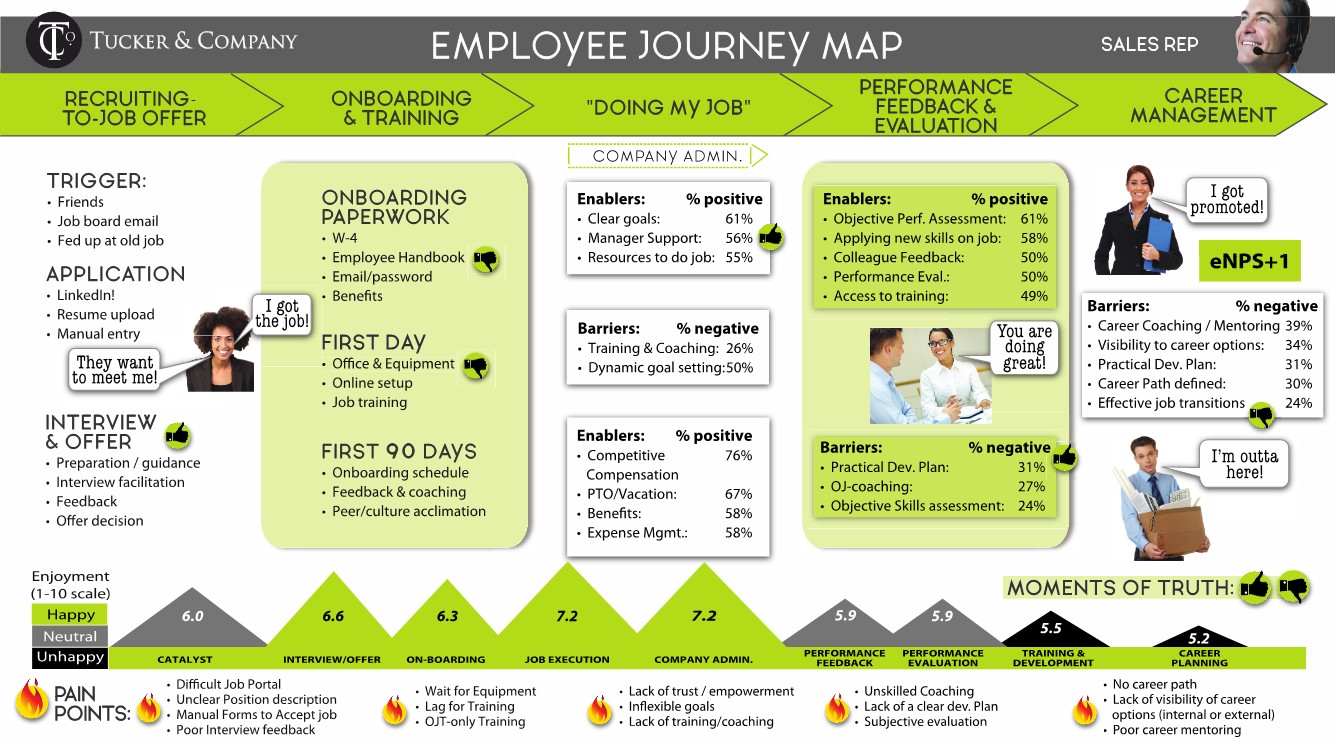Leaders across virtually every industry want to increase employee engagement and lower attrition, especially as millennials continue to dominate the workforce. This is obviously a huge challenge to the Human Resources department, but the ramifications of disengagement reach all the way to the top levels of a company. Across the US, Gallup estimates that low employee engagement costs businesses $450 – $550 billion annually, and negatively affect customer service, communication effectiveness, and productivity.
Human resources departments typically try a variety of approaches to solving this problem, from re-evaluating their perks and benefits packages to holding more company happy hours. But many miss an opportunity to get to the root of the issue by mapping their end-to-end employee journey. Journey mapping is done by many businesses to track the path-to-purchase their customers – everything from discovery, research, evaluation, purchase and use. Few apply the same rigor to their employee journey.
1. Your employee experience is fragmented. In most companies, the employee experience is extremely fragmented. From the very start, employees encounter dozens of different departments, managers, policies and hassles. The employee is handed off from one group to another along the journey just as if they were in a production line. Few of the departments know what happened to the employee before, or what will happen to them after. This fragmentation causes low engagement, mis-aligned execution of the company strategy, a low-quality customer experience, and ultimately, increased employee attrition.
2. Your employee experience is “off-brand”. At one of my first jobs out of business school, the CEO began the day by spending four hours with the group of new hires, discussing the company strategy, how we differentiate ourselves from competitors and the key role each of us play in the strategy. He answered our questions and talking about the values of the company. This set a tone immediately. As employees, we felt valued, and knew the priorities of the business right off the bat. It was a very “on-brand” experience.
Contrast this with a job I took a few years later, when it took two weeks after I started to receive the laptop required for me to do my work. Their process required that I have an approved login before the equipment could be ordered – and that I couldn’t get a login until I officially started. This gave me a first impression that the company cared more about policies and procedures than employee productivity. Not only did this first experience not set me up for success; my impression proved true throughout other inflection points in my journey there.
The reality is, a cohesive, on-brand experience for employees can make the difference between an engaged and unengaged workforce – and this pays off monetarily. Companies with an engaged workforce caused by a streamlined, cohesive employee journey have 33 percent higher profitability than those that don’t, according to 2015 PwC studies.
Take Southwest: from hiring to their promotion cycle, every touchpoint an employee has with the company is on brand. As a company, one of their values is fun, so they have each employee tell a joke at their interview. It may be a small gesture, but threading their values into each employee experience makes a huge difference in engagement. As a result, Southwest Airlines delivered 44th straight years of profitability – a huge achievement in a volatile industry.
3. Contrasting Engaged and Disengaged Employees illuminates critical gaps
Most employee surveys show average scores and compare one department vs. another. The differences are typically not very large and the insights not very meaningful. Our experience is that by contrasting the experience of highly-engaged employees vs. low-engaged employees across the journey, the “potholes” along the journey can quickly be identified. Not only that, the internal best practices of different managers and departments can be identified and quantified, making the development of an improvement plan fast and believable.
Increasing Engagement through Employee Journey Mapping
Revamping the employee experience and creating a more on-brand journey from ”hire-to-retire” can start with an employee journey map. Like a customer journey map, this exercise should be well-organized and researched-based, including:
• Employee segmentation and persona identification
• Focus groups with key employee segments
• Leveraging Employee survey data and “social media”
• Interviews with key leaders
• Collection and integration of key employee metrics along the journey
• Validation with employees and leaders
Mapping the employee journey gives a company a clear picture of what an employee experience looks like, and clearly delineates gaps and areas of opportunity.

HR departments and department managers are quickly able to articulate where fragmentation exists, where the journey is “on-brand” and “off-brand” and have employee-suggested approaches to solve for barriers. Action planning can be done with confidence and precision – and the benefits can be rapid and staggering. When employees feel part of an on-brand experience, employees feel like they’re invested in a clear path to success. They have a clear career acceleration, and know that they can reach the next level through high performance and delivering quality service.
From an employee morale and retention perspective, to your company’s bottom line, employee journey mapping can make all the difference.



